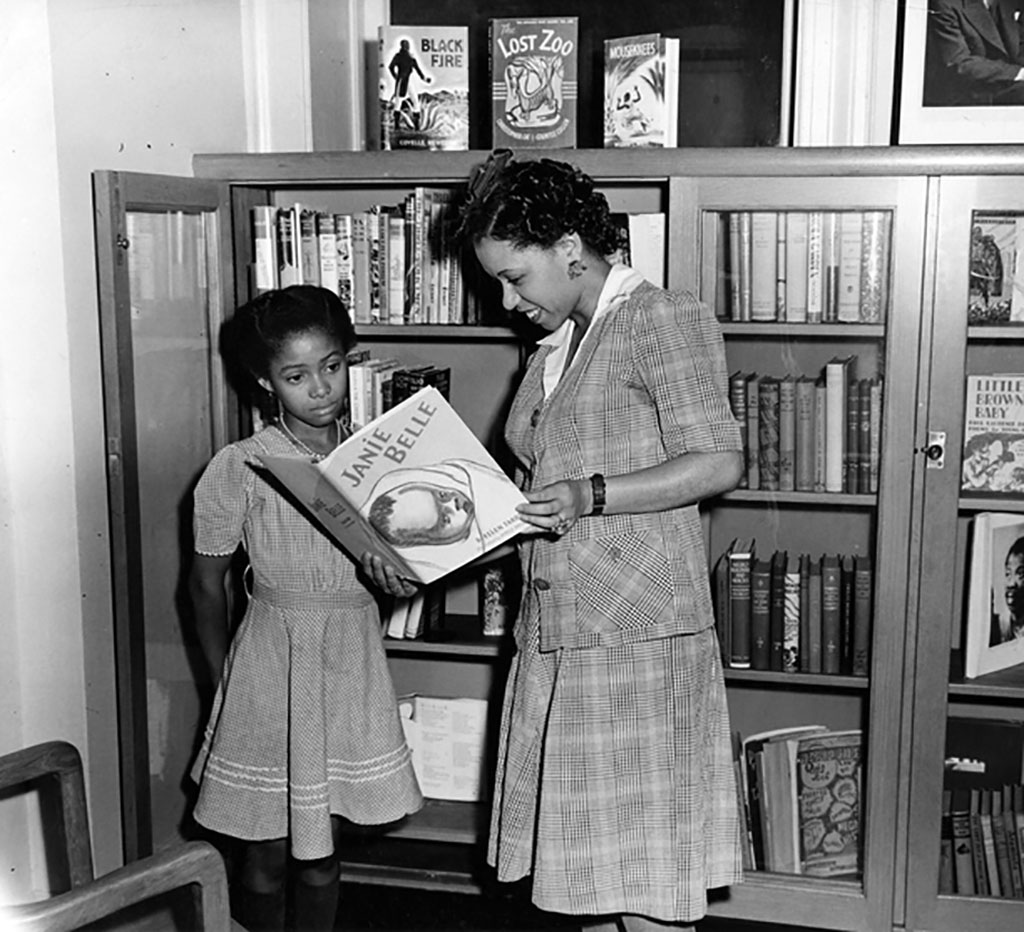
Unveiling Heroes: Rita Cox
Rita Cox
Librarian Augusta Baker at the 135th Street (now Countee Cullen) Library, Harlem, New York, ca. 1941. Courtesy of the New York Public Library.
Boys and Girls House, St. George Street, Toronto, ca. 1922. Courtesy of the Toronto Public Library.
Librarian Rita Cox telling a story at the Boys and Girls House ca. 1970. Courtesy of the Toronto Public Library.
Portrait of Rita Cox. Image by Gerda Boateng, 2021. Courtesy of BSAM Canada.
Library child
Born in Trinidad, Rita Cox grew up in a rich oral tradition of storytelling. As a child, Cox was a fixture in her local library, spending hours reading. Cox has described herself as a ‘library child’: aspiring to become a librarian from a young age. Cox became a library page at age eleven and her love of storytelling motivated her to pursue studies in library sciences in the U.S. as an adult. She joined the New York Public Library during her studies and fell in love with children’s libraries.
With encouragement from her mentor, famous storyteller and librarian Augusta Baker – who introduced ‘story hours’ into the New York Public Library System in the 1950s – Cox began telling stories as a library assistant in New York City. Pulling from her Trinidadian heritage, she began a tradition of telling Anansi stories and Caribbean folktales to children visiting the library.
Joining the Toronto Public Library
In 1960, Cox’s interest in children’s literature led her to work as a librarian at the “Boys and Girls House” at the Toronto Public Library. The House first opened in 1922 on St. George Street and was often considered to be the first purpose-built children’s library in the British Commonwealth.
Cox was promoted to head librarian at the TPL’s Parkdale Branch in 1972, a position she held for 24 years. During her time there, Cox introduced several community programs, including the literacy-focused Project Read in 1977 after a parent confided in her that they were unable to read stories to their children. This project blossomed into an ongoing community-based adult literacy program. An author herself, Cox published numerous stories, including the 1977 children’s book How Trouble Made the Monkey Eat Pepper.
Building a Caribbean heritage collection
Inspired by her own history as a Caribbean immigrant and the diversity of Parkdale’s community, Cox developed a collection of literature more representative of the Parkdale community. Cox saw a growing Caribbean population whose literature was not reflected on Toronto library shelves.
Beginning in 1973, Cox and her library staff began collecting Caribbean-focused books from Jamaica, Trinidad, and beyond, forming the basis of a new collection. The collection eventually expanded to also include African and African-American literature. In 2006, this Parkdale library collection was re-named the Rita Cox Black and Caribbean Heritage Collection. Today, this heritage collection contains more than 16,000 books, DVDs, CDs, newspapers, and magazines which focus on Black and Caribbean experiences in Canada. It is the largest circulating collection of its kind in Canada.
Storytelling in the community
After her retirement in 1995, Rita Cox remained close to the Parkdale community by taking part in numerous steering committees. She was appointed a citizenship court judge in 1995 by the Federal Government and was appointed a Member of the Order of Canada for her outstanding work in storytelling and literacy in 1997.
As a storyteller from her youth, Rita Cox saw the library as a community space of sharing and used stories to breathe life into her community. She created welcoming and celebratory spaces for Black voices and embedded the cultures and stories of Black and newcomer communities into the fabric of Parkdale.
The Enchanting Griot
As part of BSAM Canada’s “Unveiling Heroes of the Block” project, artist Gerda Boateng created a stylized portrait of Rita Cox titled “The Enchanting Griot.” As Boateng describes her: “Rita Cox is the epitome of an educator. Someone who has the ability to tell and convey stories and bring them to life, if you’ve seen her speak she exudes wisdom. It was only fitting that her superpower be the power of the mind … my depiction of Rita begins with her tribal marks, these marks are supposed to show her connection to her roots.”
“When her forehead glows her powers are activated. Her crown on her head glows when her tribal marks glow to also show her power. The flowers connected to her crown express her tropical connection to Trinidad and Tobago…Her tunic is violet, a colour to express wisdom with images of flowers to showcase her fun bright personality, while tying it to the tropics of her home Caribbean country, Trinidad.”

